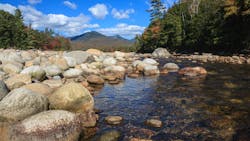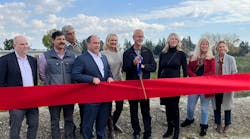The New Hampshire Department of Environmental Services (NHDES) announced that its Watershed Assistance Section has awarded seven grants for watershed protection and restoration projects totaling $510,000.
The grants are provided through NHDES’s Watershed Assistance Grants, which focus on nonpoint source (NPS) pollution prevention and reduction. Funding for the program is provided through Clean Water Act Section 319 funds from the U.S. EPA.
NHDES says that proposals received for Watershed Assistance Grants are ranked based on criteria including: water quality improvement or protection; cost/benefit ratio; local capacity to complete the project; relative value or significance of the water body; priority ranking in the NHDES Nonpoint Source Management Plan; and general quality and thoroughness of the proposal.
Each year, the Watershed Assistance Grant program requests applications for projects that will accomplish important work to reduce NPS pollution in the state’s waterbodies.
The following projects were selected in 2022 based on the results of the ranking process and available federal grant funding levels:
- Nature Conservancy: Oyster River-Caldwell Brook, Emerald Acres Culvert Replacement, Phase II, Aquatic Organism Passage/Geomorphic Compatibility/Water Quality, $125,000
This project will restore aquatic organism passage and geomorphic compatibility at Topaz Drive’s crossing of the Oyster River in Barrington. The current perched culvert will be replaced with a 30-foot bridge. The project will result in 5.2 miles of fully reconnected upstream habitat, improvement of a dissolved oxygen impairment upstream of the culvert, and mitigated flood risk. - Country Pond Lake Association: Country Pond Watershed Management Plan Implementation Phase 1: Direct Drainage Area – Newton Boat Ramp and Concannon Road BMPs, $15,000
Country Pond is on the state's impaired waters list for Primary Contact Recreation (swimming) due to frequent cyanobacteria blooms. The primary cause of algal blooms in Country Pond is high phosphorus levels caused by development around the lake and excess stormwater runoff. This project will allow the Country Pond Lake Association to implement two best management practices (BMPs) at the Newton Town Boat Ramp and on Concannon Road to divert and infiltrate stormwater runoff. - Winnisquam Watershed Network: Winnisquam Watershed Based Plan Implementation Phase 1: Demonstration BMPs Demonstration BMPs at Gale Ave Park, Deer Park, and Kaulback Road, $125,000
This grant will allow the Winnisquam Watershed Network (WWN) to design and install structural BMPs at three sites that discharge excess sediment and nutrients to Lake Winnisquam. The WWN will partner with the City of Laconia, Deer Park Association and the Town of Sanbornton to manage stormwater runoff, erosion and drainage at each site. - Lake Winnipesaukee Association: Moultonborough Bay and Winter Harbor Watershed Management Plan Implementation Phase 1: Melvin River BMPs, Northwood Road. BMP, and Winter Harbor BMP Designs, $110,000
Nutrient loading to Lake Winnipesaukee is over 300% natural background levels, which has led to the lake being listed on the NHDES 303(d) list as impaired for aquatic life use. A direct relationship exists between increased levels of nutrients in the lake and aquatic plant and algal growth, and cyanobacteria abundance. This project will implement BMPs at three priority sites in the Moultonborough Bay watershed to reduce sediment and nutrient loading. This project includes conceptual designs for culverts along Whitegate Road, Wolfeboro, and the installation of bioswales and rain gardens to reduce stormwater runoff. - Acton Wakefield Watersheds Alliance: Implementation of the Pine River Pond Watershed Protection Plan Phase 1: Residential and Road BMPs, Septic System Replacements, Outreach, $75,000
In 2019, Pine River Pond began experiencing blooms of benthic cyanobacteria mats spreading on the rocky and sandy substrates of several shallow areas. Through this project, BMPs will be installed on private camp roads and residential properties around the pond to eliminate sources of stormwater runoff and sediment pollution. This project also includes a septic system cost-share replacement program for lake residents, to assist homeowners with septic construction costs. This program gives priority to replacements that have the greatest impact on pond quality by reducing nutrient loading. BMPs and new septic systems will decrease nutrient loading into Pine River Pond. - New Hampshire Rivers Council: Winnicut River Watershed Restoration and Management Plan: Greenland Central School multi-disciplinary implementation (phase I), $15,000
The Winnicut River is one of seven major tributaries to Great Bay. The Winnicut River and several of its tributaries are impaired due to low levels of dissolved oxygen and elevated levels of E. coli. The water quality and habitat of the Winnicut River and several of its tributaries have been degraded by increased nonpoint source (NPS) pollution resulting from rapid land development in the watershed over the past 20 years. This project will install a 400 square foot rain garden at Greenland Central School to infiltrate runoff from the parking lot. The project described will reduce phosphorus and nitrogen pollutant loading into the Winnicut River and Great Bay. - Town of Exeter: Squamscott/Exeter River, Water Integration for Squamscott-Exeter (WISE) Integrated Plan:Stormwater Designs, Advanced Septic System, and Fertilizer Reduction, Exeter, New Hampshire, $45,000
The Exeter-Squamscott River is a major tributary to Great Bay. The Great Bay watershed has experienced population growth and an increase in development that has threatened the water quality and health of Great Bay. The project will identify locations and develop designs for structural best management practices (BMPs) within the Town to control stormwater runoff and decrease nitrogen loading, develop a septic system program to identify ideal locations for maximum nitrogen reduction, conduct resident public education and outreach, and explore financial incentives to assist private property owners with implementation of an advanced septic system aimed at nitrogen reduction; and develop a fertilizer reduction program to educate stakeholders on the effective and efficient use of fertilizer, BMPs, and the impacts fertilizer has on the Squamscott River and ultimately, Great Bay.






